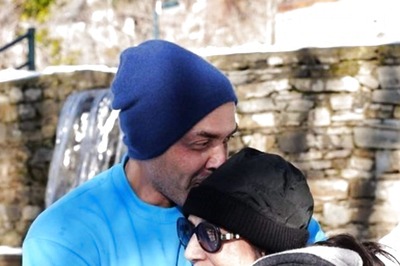
views
New Delhi: Born on July 14, 1862 in Baumgarten, near Vienna, Gustav Klimt was the renowned Austrian symbolist painter. To celebrate his 150th birthday, Google replaced its usual homepage logo with the Google doodle that includes Klimt's famous painting - the Kiss. 'The Kiss' is a 1907-08 oil and gold leaf on canvas painting that many believe to be Gustav Klimt's only self-portrait.
Who was Gustav Klimt?
To receive training as an architectural painter, Klimt was enrolled in the Vienna School of Arts and Crafts (Kunstgewerbeschule) in 1876, where he studied until 1883.
In 1888, Klimt received the Golden order of Merit from Emperor Franz Josef I of Austria for his contributions to murals. Both Klimt's father and brother Ernst died in 1892. Following this, he had to take up financial responsibility for his father's and brother's families, which adversely affected his artistic vision.
In the early 1890s, Klimt met Emilie Floge, who was to be with him until the end of his life. However, it is debated that whether his relationship with Floge was sexual or not, but during that period Gustav Klimt fathered at least 14 children.
In 1894, Klimt was asked to design three paintings to adorn the ceiling of the Great Hall in the University of Vienna. His three paintings - Philosophy, Medicine and Jurisprudence were picked apart for their radical themes and material, which was called "pornographic".
In 1902, Klimt designed the Beethoven Frieze painting for the 14th Vienna Secessionist exhibition. Meant for the exhibition only, the frieze painting was painted directly on the walls with light materials. After the exhibition, the painting was preserved, and it did not go on display until 1986.
Gustav Klimt's 'Golden Phase' was marked by positive critical reaction and success. He made the use of gold leaf in most of his paintings. The works most popularly associated with this period are the Portrait of Adele Bloch-Bauer I (1907) and The Kiss (1907-1908).
During the period from 1907 and 1909, Klimt painted five canvases of society women wrapped in fur. In 1911, one of his paintings - Death and Life -bagged first prize in the world exhibitions in Rome.
Gustav Klimt is also known for his erotic paintings of nude women. Quite like fellow Austrian Sigmund Freud, Gustav Klimt brought sexuality into the public sphere. He was once forced to take down a particularly controversial painting that showed a naked pregnant woman.
Gustav Klimt and his work have been the subjects of many collector coins and medals.
He died in Vienna on February 6, 1918 after contracting Spanish flu during the 1918 flu pandemic.
In 2006, Klimt, an Austrian art-house biographical film about the life of Gustav Klimt (1862–1918) was made. It was written and directed by Raoul Ruiz.
Belvedere devotes an exhibition
On the occasion of the 150th birth anniversary of the Austrian symbolist painter Gustav Klimt, the Belvedere is preparing a very special presentation.
The exhibition - Masterpieces in Focus: 150 Years of Gustav Klimt - on the Upper Belvedere's piano nobile will cast new light on what is the largest collection of Klimt's painting worldwide.
Unlike most exhibitions of recent years, it will not deal with stylistic relationships or art historical contexts, but will concentrate on the works as such – on the message each of these masterpieces conveys to the spectator.
Besides principal works by the artists, such as The Kiss and Judith, the show will include two new additions to the collection. Coming from a private estate, the paintings Sunflower and Family entered the Belvedere in March 2012, so that the museum's Klimt holdings have now risen to as many as 24 paintings.
Over 150 years, Klimt has become a phenomenon not only in art theory, but also in contemporary history. The interdisciplinary approach and the selection of the objects, as well as the show's graphic and multimedia format, will certainly contribute to transmitting to the spectator Klimt's art and its consequences on an entirely new level of understanding.
His masterpieces
Here are some of the masterpieces by Gustav Klimt:

Kiss, 1908, Oil, silver and gold plating on canvas, 180 x 180 cm

Judith, 1901, Oil and gold plating on canvas , 84 x 42 cm

Avenue in the Park of Schloss Kammer, 1912, Oil on canvas, 110 x 110 cm

Court actor Josef Lewinsky as Carlos in Clavigo, 1895, Oil on canvas, 60 x 44 cm

Farm Garden with Sunflowers, 1907, oil on canvas, 110 x 110 cm

Fritza Riedler, 1906, Oil on canvas, 153 x 133 cm

Friends (Water Snakes I), 1904–1907, Mixed media and gold on parchment, 50 x 20 cm

Salome, 1909, Oil on canvas, 176 x 46 cm

The Family, 1909/1910, Oil on canvas, 90 x 90 cm

Portrait of Bruno Grimschitz, 1915, Oil on canvas, 159,5 x 108 cm

Mother and Two Children, 1915–1917, Oil on canvas, 150 x 160 cm
The photos have been taken from www.belvedere.at



















Comments
0 comment